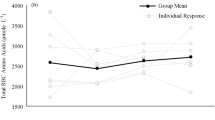Summary
The aim of the study was to investigate the distribution of lactate in plasma, whole blood, erythrocytes, and capillary finger blood, before and during submaximal exercise. Ten healthy male subjects performed submaximal graded cycle ergometer exercise for 20–25 min. Venous blood samples and capillary finger blood samples were taken before exercise and every 5th min during exercise for lactate determination. The plasma lactate concentration was significantly higher (P<0.001, approximately 50%) than in the erythrocytes. This difference was not altered by the venous blood lactate concentration or exercise intensity. A significant difference (P<0.01) in lactate concentration was also found between capillary whole blood and venous whole blood. It was concluded that direct comparisons between lactate in capillary finger blood, venous whole blood and plasma could not be made.
Similar content being viewed by others
References
Åstrand P-O, Hultman E, Juhlin-Dannfeldt A, Reynolds G (1986) Disposal of lactate during and after strenuous exercise in humans. J Appl Physiol 61:338–343
Buono M, Yeager J (1986) Intraerythrocyte and plasma lactate concentrations during exercise in humans. Eur J Appl Physiol 55:326–329
Coyle EF, Martin WH, Ensani AA, Hagberg JM, Bloomfeld SA (1983) Blood lactate threshold in some well-trained ischemic heart disease patients. J Appl Physiol 54:18–23
Decker DG, Rosenbaum JD (1942) The distribution of lactic acid in human blood. Am J Physiol 138:7–11
De Coster A, Denolin H, Messin R, Degre S, Vandermoten P (1969) Role of the metabolites in the acid-base balance during exercise. Med Sport 35:15–34
Devadatta SC (1934) Distribution of lactate between corpuscles and the plasma in blood. Q J Exp Physiol 24:295
Farrell PA, Wilmore JH, Coyle EF, Billing JE, Costill DL (1979) Plasma lactate accumulation and distance running performance. Med Sci Sports 11:338–344
Harris R, Dudley G (1989) Exercise alters the distribution of ammonia and lactate in blood. J Appl Physiol 66:313–317
Hollman W (1961) Zur Frage der Dauerleistungsfähigkeit. Fortschr Med 17:439–446
Johnson RE, Edwards HT, Dill DB, Wilson JW (1944) Blood as a physicochemical system. XIII. The distribution of lactate. J Biol Chem 157:461–473
Kumagai S, Tanaka K, Matsuura Y, Matsuzaka A, Hirakoba K, Asano K (1982) Relationships of the anaerobic threshold with the 5 km, 10 km, and 10 mile races. Eur J Appl Physiol 49:13–23
Mazzeo R, Brooks GA, Schoeller DA, Budinger TF (1986) Disposal of blood [1-13C] lactate in humans during rest and exercise. J Appl Physiol 60:232–241
Morgan DW, Baldini FD, Martin PE, Kohrt WM (1989) Ten kilometer performance and predicted velocity at \(\dot V_{{\text{O}}_{{\text{2 max}}} }\) among well-trained male runners. Med Sci Sports Exerc 21:78–83
Noble BJ, Borg G, Jacobs I, Ceci R, Kaiser P (1983) A categoryratio perceived exertion scale: relationship to blood lactate and muscle lactate and heart rate. Med Sci Sport Exerc 15:523–528
Poortmans JR, Delescaille-Vanden Bossche J, Leclerq R (1978) Lactate uptake by inactive forearm during progressive leg exercise. J Appl Physiol Respir Environ Exerc Physiol 45:835–839
Salha SD, Morishima HO, James LS, Adamsons K Jr (1964) Lactate and pyruvate gradients between red blood cells and plasma during acute asphyxia. J Appl Physiol 19:1100–1104
Schwab W von, Tritschler W, Kessler A, Bablock W (1979) Neue enzymatische Lactatbestimmung: methodische Aspekte und Probengewinnung. J Clin Biochem 17:65–70
Sjödin B, Jacobs I (1981) Onset of blood lactate accumulation and marathon running performance. Int J Sports Med 2:23–26
Sjödin B, Svedenhag J (1985) Applied physiology of marathon running. Sports Med 2:83–99
Wandrup J, Tvede K, Grinsted J, Jordening H (1989) “Stay” measurements of L-Lactate in whole blood and cerebrospinal fluid assessed. Clin Chem 35:1740–1743
Weil MH, Leavy JA, Rackow EC, Halfman CJ, Bruno SJ (1986) Validation of a semi-automated technique for measuring lactate in whole blood. Clin Chem 32:2175–2177
Williams C, Nute ML (1983) Some physiological demands of a half-marathon race on recreational runners. Br J Sports Med 17:152–161
Yoshida T, Takeuchi N, Suda Y (1982) Arterial versus venous blood lactate increase in the forearm during incremental bicycle exercise. Eur J Appl Physiol 50:87–93
Author information
Authors and Affiliations
Additional information
The study was performed at the Department of Clinical Physiology, University Hospital, S-75185 Uppsala, Sweden
Rights and permissions
About this article
Cite this article
Foxdal, P., Sjödin, B., Rudstam, H. et al. Lactate concentration differences in plasma, whole blood, capillary finger blood and erythrocytes during submaximal graded exercise in humans. Eur J Appl Physiol 61, 218–222 (1990). https://doi.org/10.1007/BF00357603
Accepted:
Issue Date:
DOI: https://doi.org/10.1007/BF00357603




